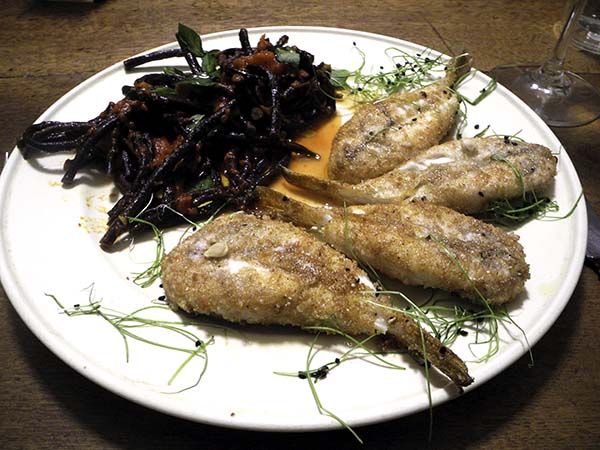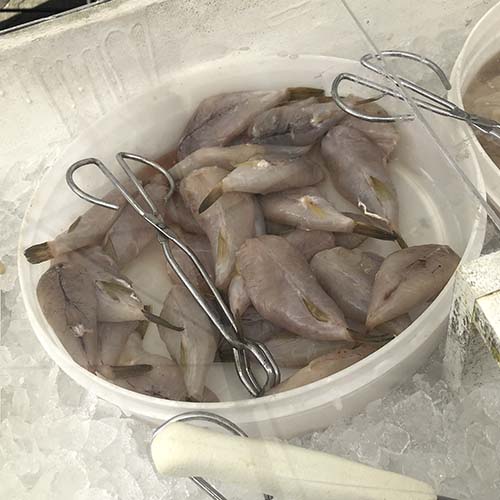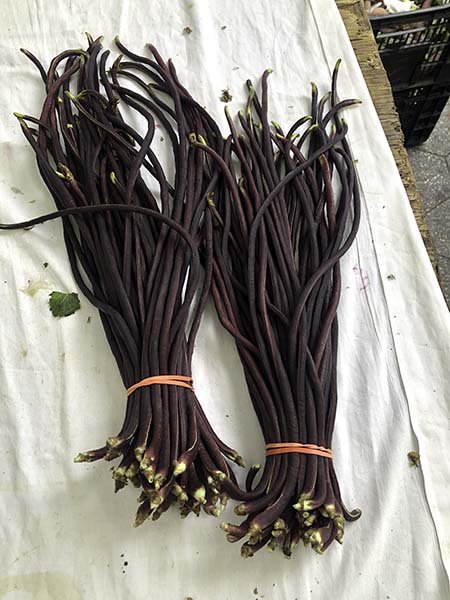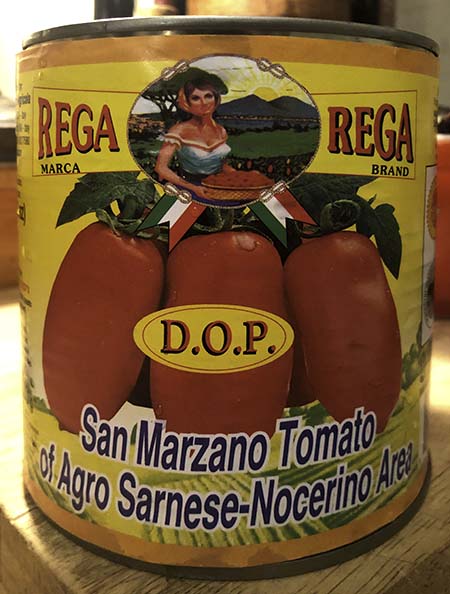
We both chose the blowfish on our own, without any visual stimulus, and unanimously (Barry by responding to the photo I had sent him of the fish board that day, via Slack), but the vegetable seemed to have invited itself, once I had spotted two bunches of long beans that remained on the farmer’s table at the Greenmarket on Monday.
Today many of us think that Italians traditionally tend to overcook their vegetables, but author of the recipe on which I based my preparation of these (very un-Italian beans) has a different take:
If you ask me, people don’t overcook their vegetables often enough. The truth is, vegetables can sometimes be absolutely delicious when cooked until there isn’t a trace of crispness left. In fact, some vegetables practically require long cooking—like these long beans braised in tomatoes, which are best only after you’ve cooked them to death.
I can understand the concept, at least in this case.

- eight local blowfish tails (exactly one pound together) from P.E. & D.D. Seafood Company, dredged in about 2 ounces of a local Union Square Greenmarket-purchased whole wheat flour (from the Blew family of Oak Grove Mills Mills) that had been seasoned with plenty of local P.E. & D.D. Seafood Company sea salt, freshly ground black pepper, about half a teaspoon of Colman’s ground mustard seed, and a pinch or more of some home-dried darker golden habanada pepper, pan-fried in olive oil about an eighth to a quarter of an inch deep inside a very large well seasoned heavy cast iron pan, turning them over once (cooking about 2 to 2½ minutes on each side), by which time they had turned beautifully golden), drizzled with juice of an organic California lemon from Whole Foods Market, and garnished with micro scallion from Two Guys from Woodbridge


- twelve ounces of purple Asian long beans (the color remains after cooking) from Lani’s Farm, washed, trimmed, cut into 4 or 5-inch lengths, placed inside a large antique high-sided copper pan/pot in 2 tablespoons of olive oil in which 2 medium cloves of ‘Chesnok Red’ garlic from Alewife Farm and a bit of dried Itria-Sirissi chili, pepperoncino di Sardegna intero from Buon Italia had first been heated over a medium flame, stirring, until the garlic had begun to color, the heat raised to high and cooked, again, stirring, until the beans had become bright purple and begun to sear, 3 to 4 minutes, seasoned with salt and pepper, then most of one can of San Marzano (Italian San Marzano, Italian San Marzano D.O.C.) tomatoes and their juices, the tomatoes themselves first crushed by hand, added to the pan, along with a third of a cup of water that had first been swished around the empty tomato can, the mix brought to a simmer and the heat lowered just enough to maintain that simmer, cooked uncovered, stirring occasionally, until the beans were very tender and the tomato had reduced to a thick sauce, or about 30 minutes, at which point 2 tablespoons of packed fresh peppermint leaves, also from Lani’s Farm, and 2 tablespoons of olive oil were mixed in [NOTE: this dish could also be served at room temperature, or refrigerated and rewarmed before serving.]
- the wine was a Spanish (Catalonia/Tarragona/Monsant) white, Franck Massard Herbis Verdejo 2018, from Naked Wines
- the music was a recording of two symphonies by Karl Friedrich Abel (1723-1787), Michael Alexander Willens conducting the Cologne Academy